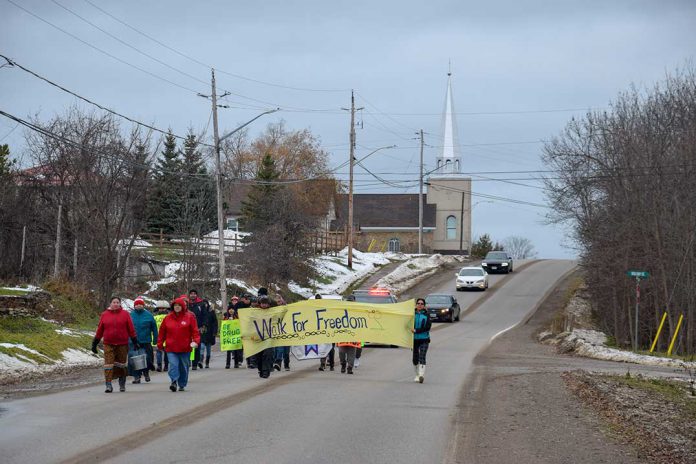SUDBURY—Lung cancer is responsible for 25 percent of all cancer deaths in Ontario, making it the leading cause of cancer death in the province, but a low-dose CT scan that may be able to detect cancer at a much earlier stage than usual holds out hope of turning that statistic around. So far the pilot program investigating pre-cancer has proven so successful that it has been extended for a second year and those with a long history of smoking are encouraged to contact the program to find out if they qualify.
“The first year went very well,” said Dr. Amanda Hey, who explained that the Manitoulin-Sudbury region was one of three sites offering the program in Ontario. “We were chosen because of our demographics.” Those demographics show that Northern Ontario, and especially Manitoulin-Sudbury, have very high rates of smoking, particularly among the First Nations. “There is a higher smoking rate and higher incidents of lung cancer,” she said.
For Debra Jeanveau of Espanola, the program has provided a tremendous peace of mind.
“I went to see the doctor because I am a smoker,” she said. Although Ms. Jeanveau entered the program through a referral from her doctor, that is not necessary—people can self refer as well. “They set up the appointment for me, I didn’t have to do anything except show up,” she said. “The woman on the phone was very helpful. If anything showed up they would deal with it right away.”
The program uses a low dose computerized tomography (CT) scan to find issues at the early stages where there is a better chance of a positive treatment outcome.
A CT scan combines a series of X-ray images taken from different angles around the body and uses computer processing to create cross-sectional images of the bones, blood vessels and soft tissues inside the body. CT scan images provide more detailed information than simple X-rays do.
The new allocation of CT slots made available to the program are making it possible o double the original capacity. Once underway, the process of taking part in the study is unusually swift for a medical procedure, with wait times under 120 days.
Ms. Jeanveau described the process as “a great experience. It didn’t take long, a couple of minutes really.” For Ms. Jeanveau the results came back clear. “They will take another look in a year,” she said.
Ms. Jeanveau has been a smoker for 50 years and she admits that concerns about cancer have weighed in the back of her mind for some time.“I think everybody who has smoked for a long time should sign up for the program,” said Ms. Jeanveau.
The process is quite painless, literally.
“Usually to see a specialist it can take up to a year,” said Ms. Jeanveau. “But the doctors with the program will see you immediately.”
“This is a priority program,” noted Dr. Hey. “The reason is pretty clear. The prognosis for lung cancer survival has been historically poor due to the late discovery,” she noted. “The benefits of early detection are huge. Because it is usually detected so late, the cancer is usually in stage four by the time that symptoms normally become evident. In theory, if we can find cancer when it is at an earlier stage it can now often be successfully treated.”
In the past, there wasn’t a lot that could be done to cure a person with lung cancer because it was often found at a later stage. Now there is a test to find lung cancer early when cancer is smaller and easier to treat. “The majority of lung cancers are diagnosed at an advanced stage when treatment options are limited. Screening for lung cancer in people who are at high risk aims to detect cancers at an earlier stage, when a broader range of treatment options are available and better treatment outcomes can be achieved,” said Dr. Michael Loreto, radiologist with Health Sciences North and Regional Imaging Lead, Northeast Cancer Centre, in a release from the original announcement of the program.
The extension to the pilot program isn’t to discover if it works, noted Dr. Hey. “This is the best process of delivery,” she said. “Not to see if it works, because we already have that.”
The program is aimed at those 55 to 74 who have smoked daily for at least 20 years. Not necessarily in a row. “The smoking does not have to be consecutive,” said Dr. Hey. “This is not only for current smokers, but for former smokers as well.
If you are at high risk, getting screened regularly can lower your risk of dying from lung cancer by 20 percent. “I was apprehensive leading up to my screening appointment; what happens if they find something? But then I remembered why I wanted to do this in the first place. It’s not just for me, but for my family too,” said Steven Payne, an HSN patient advisor.
The test is free and is covered by the Ontario Health Insurance Plan (OHIP). The pilot is available to over 196,000 residents of the City of Greater Sudbury, Manitoulin, Elliot Lake, Noelville, St. Charles, Warren, Cartier and Britt. If you are 55 to 74 years old and have smoked cigarettes for at least 20 years in total, talk to your healthcare provider or call 1-844-703-0164 to see if you qualify for lung cancer screening.





